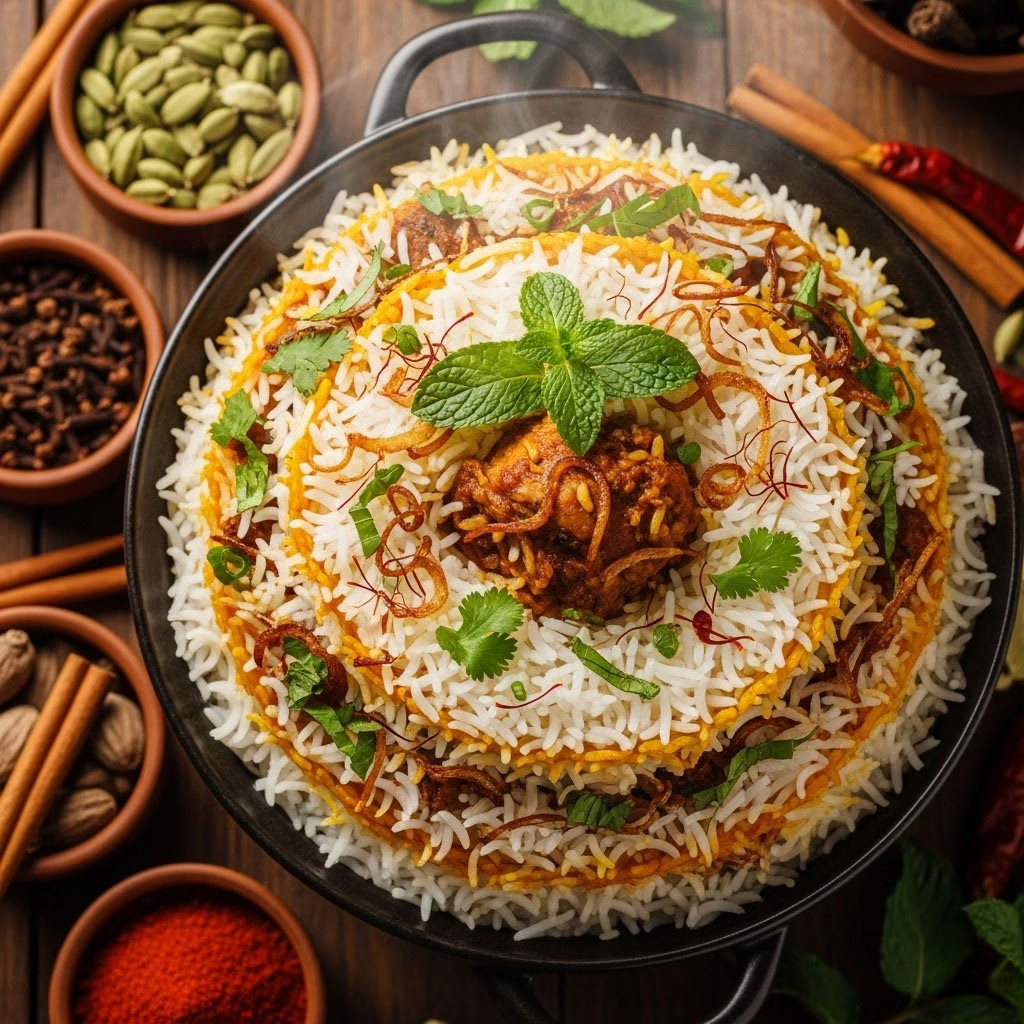The Science of Perfect Biryani: Secrets of Layering, Rice, and Spices.

Biryani is more than food—it’s poetry in a pot. Imagine a kitchen filled with the fragrance of saffron, ghee, and caramelized onions. The lid lifts, steam escapes, and there it is: long grains of rice, tender meat, and layers of spice woven together like a symphony.
Across South Asia, families guard their biryani recipes like treasure. Yet, behind every version lies the same science—layering, rice texture, spice balance, and patience.
The Art of Layering
Think of layering as storytelling. The base is the opening chapter: juicy meat or vegetables simmered with masala. The middle layers are the plot twist—semi-cooked rice, herbs, saffron, and fried onions. The top is the grand finale, sealing in aroma before the dum (steam cooking) works its magic.
When you dig in, you’re not just eating—you’re unfolding a story, spoon by spoon.
Rice Texture – The Heartbeat of Biryani
Rice decides whether your biryani is a masterpiece or a disappointment. Fluffy, long, separate grains are the heartbeat of this dish. That’s why chefs insist on aged basmati and the “70% rule”—boil the rice until it’s almost done, then let the dum finish the job. Too soft and it clumps; too raw and it ruins the bite. Perfect rice is like perfect timing in a love story—it makes everything come together.
Spice Balance – A Symphony of Flavors
Biryani isn’t meant to be fiery—it’s meant to be layered. Whole spices like cinnamon and cardamom perfume the pot, while ground spices add warmth and depth. Fresh herbs and fried onions bring sweetness and brightness. The magic lies not in one spice, but in how they play together—like instruments in an orchestra.
Common Mistakes to Avoid
Overcooking rice (hello, mushy biryani!)
Adding too much water during dum
Skipping the resting stage after cooking
Random layering instead of mindful stacking
Cooking on high flame and burning the bottom
Each mistake teaches a lesson, but once you master them, biryani becomes effortless.
Pro Tips for Beginners 🌿
Soak your rice for at least 30 minutes before boiling—it helps grains cook longer and fluffier.
Marinate meat overnight for deeper flavor and tenderness.
Always fry onions till golden brown, not dark brown (burnt onions turn bitter).
Use a heavy-bottomed pot or place a tawa (griddle) under your biryani pot to prevent burning.
Let the biryani rest for 10–15 minutes before serving—this “pause” lets the flavors settle beautifully.
Regional Variations – One Dish, Many Stories 🍲
Hyderabadi Biryani – Famous for its raw cooking method, where marinated meat and raw rice are layered together and cooked on dum. Spicy, rich, and royal.
Lucknowi (Awadhi) Biryani – Delicate and aromatic, often using the pakki method (cooked meat layered with rice). Lighter on spice, richer in subtle flavors.
Malabar Biryani – From Kerala’s coast, it often features short-grain rice (jeerakasala or kaima), ghee-rich flavors, and seafood or chicken. Slightly sweeter, with Arabian influences.
Every region whispers its own story through biryani, proving there’s no single “right” way—only the one that speaks to your heart.
Final Thoughts
Cooking biryani is like learning patience, balance, and care—all in one dish. It teaches us that when layers are built with thought, when rice is treated with respect, when spices dance in harmony, and when we wait just long enough for dum to weave its magic—something extraordinary happens.
That’s the true science of biryani: turning ingredients into emotions and a simple meal into a celebration.


You Might Also Like
A Sharp Reminder: Keep Your Knife Safe and Clean!
Knives are essential tools in every kitchen, but mishandling or improper storage...
Preparing and Serving Kerala Sadya
Kerala, a southern state in India, is known for its rich cultural...
From Humble Beginnings to Global Fame: The Story of KFC & Colonel Sanders.
Discover how Colonel Sanders turned a small roadside diner and his secret...
Embracing the Spirit of Ramadan: A Time for Reflection, Gratitude, and Togetherness.
As the blessed month of Ramadan begins, it's a time for reflection,...
Payasam: A Taste of Kerala’s Festive Spirit
Payasam, a creamy and aromatic dessert, is a staple in Kerala's culinary...
The Grand Onam Sadya: A Celebration of Tradition and Taste.
Explore Kerala’s Onam Sadya, a lavish vegetarian feast served on a banana...